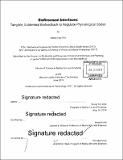| dc.contributor.advisor | Hiroshi Ishii. | en_US |
| dc.contributor.author | Choi, Kyung Yun. | en_US |
| dc.contributor.other | Program in Media Arts and Sciences (Massachusetts Institute of Technology) | en_US |
| dc.date.accessioned | 2020-01-23T17:01:44Z | |
| dc.date.available | 2020-01-23T17:01:44Z | |
| dc.date.copyright | 2019 | en_US |
| dc.date.issued | 2019 | en_US |
| dc.identifier.uri | https://hdl.handle.net/1721.1/123633 | |
| dc.description | Thesis: S.M., Massachusetts Institute of Technology, School of Architecture and Planning, Program in Media Arts and Sciences, 2019 | en_US |
| dc.description | Cataloged from PDF version of thesis. | en_US |
| dc.description | Includes bibliographical references (pages 75-86). | en_US |
| dc.description.abstract | This thesis introduces BioResonant interfaces, which bidirectionally communicate with the user's body to provide information on their physiological state. This facilitates regulation of their stress levels and ultimately a more mindful daily life. Based on the principle of respiratory sinus arrhythmia (RSA) and physiological synchronization, the BioResonant interface is designed to stimulate at the subconscious level using subliminal tactile biofeedback. Through this process, the user's physiological state can be aligned with their desired state. I present three different forms of the BioResonant Interface, a wearable device, a cushion, and a kinetic display, which utilize either heart rate (HR) or breathing rate (BR), or both. I present their fabrication, design, and evaluation method in the following interaction scale order: local interaction with the skin; general interaction with the body; and embodied interaction with the environment. | en_US |
| dc.description.abstract | First, I introduce a mobile heart rate rhythmic regulator-ambienBeat-which provides subtle tactile stimulus. This wearable device in the form of a watch monitors heart rate and interacts with the skin in the wrist area. Second, I explore using both types of real-time biometric data-HR and BR-to regulate physiological state. somaPneu, an actuating cushion the size of an adult's upper body, provides two different forms of tactile stimulus simultaneously by changing its volume and generating a pulse. In contrast to ambienBeat, somaPneu interacts with the broader somatosensory system of the user's body. Lastly, I present a kinetic display-reSpire-which regulates users' breathing patterns through embodied tangible interactions with their inner state and with people around them. It encourages them to perform dynamic body motions to interact with the shape-changing fabrics that represent their own BR. | en_US |
| dc.description.abstract | This thesis closes by providing my vision for the BioResonant interface, which encourages a better understanding of ourselves for richer intrapersonal and interpersonal interactions. | en_US |
| dc.description.statementofresponsibility | by Kyung Yun Choi. | en_US |
| dc.format.extent | 91 pages | en_US |
| dc.language.iso | eng | en_US |
| dc.publisher | Massachusetts Institute of Technology | en_US |
| dc.rights | MIT theses are protected by copyright. They may be viewed, downloaded, or printed from this source but further reproduction or distribution in any format is prohibited without written permission. | en_US |
| dc.rights.uri | http://dspace.mit.edu/handle/1721.1/7582 | en_US |
| dc.subject | Program in Media Arts and Sciences | en_US |
| dc.title | BioResonant interfaces : tangible, subliminal biofeedback to regulate physiological states | en_US |
| dc.type | Thesis | en_US |
| dc.description.degree | S.M. | en_US |
| dc.contributor.department | Program in Media Arts and Sciences (Massachusetts Institute of Technology) | en_US |
| dc.identifier.oclc | 1136279573 | en_US |
| dc.description.collection | S.M. Massachusetts Institute of Technology, School of Architecture and Planning, Program in Media Arts and Sciences | en_US |
| dspace.imported | 2020-01-23T17:01:43Z | en_US |
| mit.thesis.degree | Master | en_US |
| mit.thesis.department | Media | en_US |
